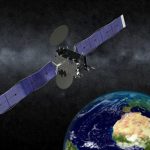The Proton M / Breeze M launch vehicle, utilising a 5-burn Breeze M Supersynchronous Transfer Orbit mission design, will lift off from Pad 39 at Baikonur Cosmodrome, Kazakhstan, with the EUTELSAT 5 West B / MEV 1 satellites on board.
 Eutelsat 5 West B is a Ku-band satellite that is intended to be located at 5° West, a key video neighborhood addressing predominantly French, Italian and Algerian broadcast markets. The new satellite will provide business continuity and improved quality for these markets via a Ku-band payload of 35 equivalent 36 MHz transponders connected to three service areas. Switchable transponders will also increase commercial flexibility. Eutelsat selected Airbus Defence and Space and Northrop Grumman to build the new satellite. Airbus Defence and Space built the satellites payload while the platform was manufactured by Northrop Grumman.
Eutelsat 5 West B is a Ku-band satellite that is intended to be located at 5° West, a key video neighborhood addressing predominantly French, Italian and Algerian broadcast markets. The new satellite will provide business continuity and improved quality for these markets via a Ku-band payload of 35 equivalent 36 MHz transponders connected to three service areas. Switchable transponders will also increase commercial flexibility. Eutelsat selected Airbus Defence and Space and Northrop Grumman to build the new satellite. Airbus Defence and Space built the satellites payload while the platform was manufactured by Northrop Grumman.
The Northrop Grumman manufactured Mission Extension Vehicle 1 (MEV-1) delivers a satellite life-extension service through the companys wholly-owned subsidiary SpaceLogistics LLC. MEV-1 docks to client vehicles in geosynchronous orbit using existing satellite features to provide attitude and orbit control of the combined vehicle stack. MEV-1 has the ability to dock and undock several times during its 15-year design life, allowing it to service multiple customers. SpaceLogistics initial service, using the MEV 1, will extend the life of the Intelsat 901 satellite for five years. SpaceLogistics is delivering the future of space by demonstrating the fundamentals of satellite servicing with MEV-1.
The Proton M / Breeze M launch vehicle, utilising a 5-burn Breeze M Supersynchronous Transfer Orbit mission design, will lift off from Pad 39 at Baikonur Cosmodrome, Kazakhstan, with the EUTELSAT 5 West B / MEV 1 satellites on board.
The first three stages of the Proton will use a standard ascent profile to place the orbital unit (Breeze M upper stage and the EUTELSAT 5 West B / MEV 1 satellites) into a sub-orbital trajectory. From this point in the mission, the Breeze M will perform planned maneuvers to inject the orbital unit first to a circular parking orbit, then to an intermediate orbit, followed by a transfer orbit, and finally to a supersynchronous transfer orbit. Separation of the EUTELSAT 5 West B and MEV-1 satellites is scheduled to occur approximately 15 hours, 36 minutes and 15 hours, 54 minutes after liftoff, respectively.














































































